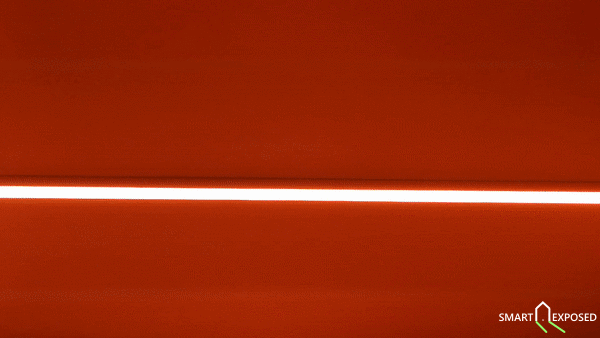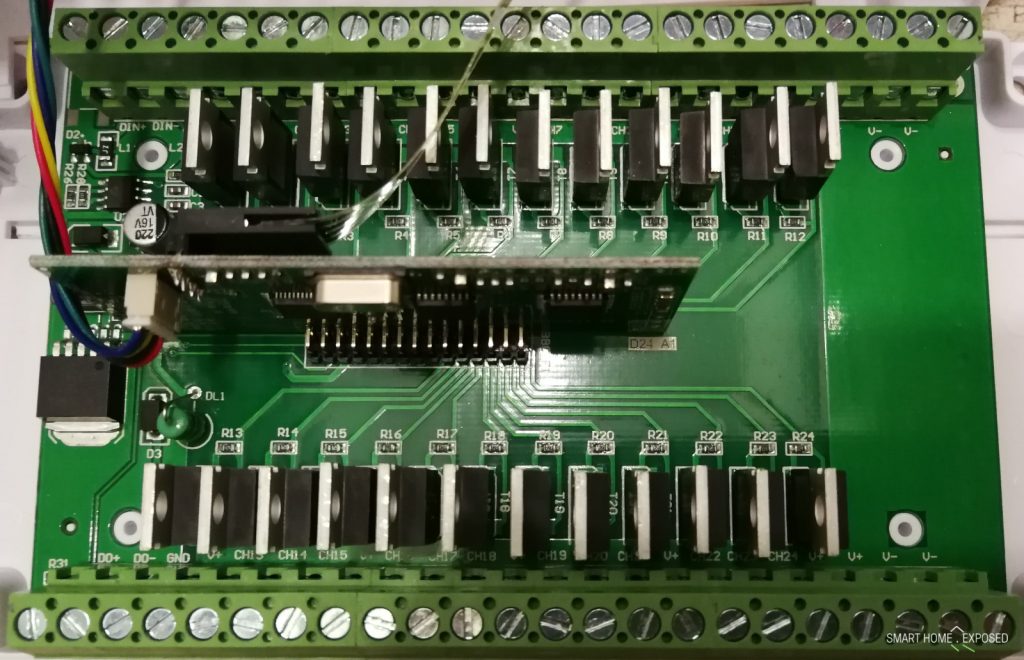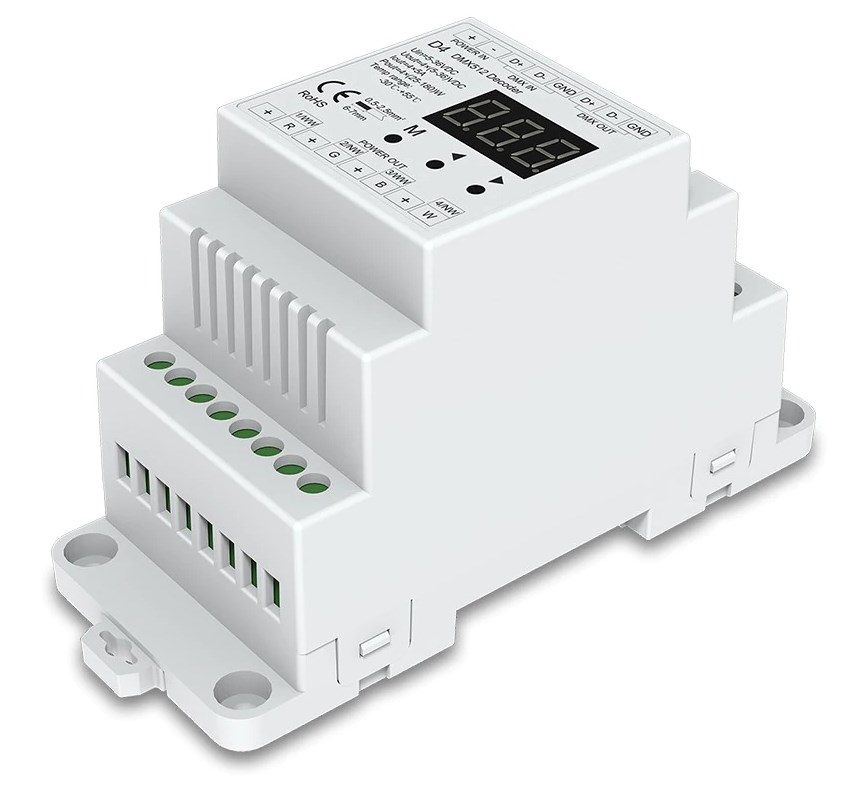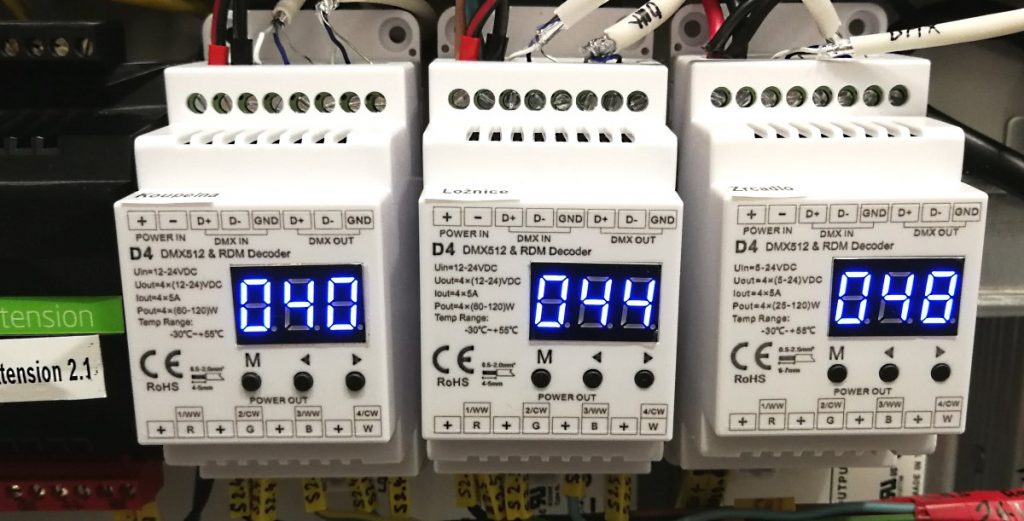Some of you might already noticed that Loxone silently discontinued few products and one of the areas impacted are DMX products. Just a simple query to their web-shop reveals that there are no 24V DMX Dimmers any longer. The focus has moved towards Tree and Air products, leaving open standards aside. Same happened to EnOcean products while ago.
But there might be other reasons why to look for other 24V dimmers as well. Before we jump right into it, let me tell you few things about the former Loxone 24V DMX dimmers. I still have 6 of these since the very beginning of my Loxone installation, and I never had any technical issue with these. They have very small space requirements in the cabinet on the DIN rail, and offer four channels at 2.1 Amps each (50W per dimming channel). But the thing here is flickering, which is often being discussed in relation with PWM dimming in general. According to the documentation, Loxone has set the PWM frequency to 123Hz. Although there were some rumours about the possibility to adjust the PWM frequency, in the end it seems it was not possible.
PWM flickering
Different people do have different sensitivity to flickering. While some do not notice flicker at 25Hz (cinema movie frame rate) or lower, others might be irritated by 100Hz refresh or higher. It depends entirely on the application and human eye natural sensitivity to flicker. It is more recognizable when subject or object is in motion, and in peripheral view where the sensitivity is improved. Some sources report that 300Hz is a frequency minimum for stationary and 1kHz for moving flicker free.
How about some upper frequency limitations? It is usually limited by the micro-controller maximum frequency, switching transistor energy efficiencies at higher speeds, and potential audible noise in the human sound spectrum. At ultra high frequencies the system would practically act as an transmitter creating electromagnetic interference all around the house.

Now back to the Loxone dimmers for a moment again. In my experience the frequency they have chosen is a bit too low, causing unwanted stroboscopic effect. It is interesting that in case of RGBW LED strips I found the flickering more noticeable on the color channels than on the WW, but this has either something to do with the response of phosphor coating that converts the blue emitted light to the white or warm white, human eye sensitivity to the given wavelengths, or combination of these factors. Simply wave your outstretched hand in front of the light source and see the difference in stroboscopic effect when switching the light channels.
Flicker-Free?
For home light appliances it is wise to consider flickering (or the PWM frequency) as another attribute to look at when comparing LED dimmers.
I heard very good references to Eldoled LINEARdrives (100D), which seems to be very advanced, flicker-free and solid dimmers. However, I couldn’t find any good dealership nearby, so I cannot provide any personal recommendations. Also, when looking at the available datasheets, there is no mention about the frequency they use, or at least I couldn’t find that detail there.
So while looking for other options I found few interesting DMX dimmers on AliExpress so I ordered a few to test.
24 Channel CVDMX512 Decoder
This is indeed an interesting product at first sight. Offering 24 individual output channels, 3 Amps each, DIN rail housing and numeric LED channel display. It offers some standalone operation modes making the device more versatile to use but I was not exploring these in detail as my primary target was to supplement Loxone 24V DMX dimmers. There are three buttons that allow you to configure or adjust few settings like operation mode, DMX channel, decoder mode, PWM frequency, brightness curve, and few others).

24 channel 24V LED DMX dimmer [AliExpress]
Decoder mode can be selected between 1, 3, 6 or 24 channels, PWM frequency can be selected to either 500Hz or 2000Hz and you choose from linear or logarithmic output curve. DMX address can be set in a range from 001 to 2048, however Loxone DMX extension cannot address more than 512 channels I think, but definitely no limitation there from the dimmer.
The fact that there are 24 individual output channels sounds amazing, and was the main reason for me to test it. When looking at the documentation I got the impression, that in facts there are two independent sets of channels with 12 outputs on the top and 12 on the bottom side of the device. That thinking was supported by the wiring diagram showing clearly, that the power supply has to be connected to the top as well as to the bottom. Unfortunately, things are a bit different, and my idea to connect two separate power supplies to each 12 channels was wrong. 🙁
Just a quick multi-meter exercise revealed that the power inputs are cross-connected on the board. That assumption was proved immediately after I opened the device. So the recommendation for separate wiring input is rather a reduction of the current the board has to carry, because at full load we are talking about 72 A altogether, where half of that would be going through the PCB. So no wonder the manufacturer is trying to reduce the stress and strongly asks to supply the power from both (top and bottom) terminals.
But this opens another problem which is the power supply itself. In case you want to use the full potential of this dimmer and use that for instance as an DMX device for lighting of multiple rooms, the PSU would have to be extremely powerful ~1728W. This is a bit insane, not just from a single point of failure perspective, but also in case of any wiring/electricity issue, the short-circuit current would create massive firework, unless you are heavily fused on each of the channels.

I was also considering an option to cut and split the wiring on the PCB, so that the top and bottom terminals could have separate power, but then I would need to tackle other issue and that is the power for the DMX controller itself, where once the bottom part is off (if you are considering switching off PSU’s when idle), the whole dimmer gets off. So I ended up with different solution – see next chapter.

Where I see this product fits best is more an entertainment or effect usage where you need a lot of channels but the total current is kept reasonably low. For instance if you want to dynamically illuminate your steps on stairway and individually address each separate one, this dimmer is the right one to be used. To achieve the same using Loxone 24V dimmers you would need six of these.
Last note, this dimmer predominantly counts on the connection to RGB LED strips. In case you have RGBW ones (which is my case as well), you’ll need to pay attention to the terminals order when connecting it, as you’ll be taking the positive terminal in the middle of the other colors, but this nothing more than just a different order of wires.
4 Channel CVDMX512 Decoder
The smaller brother of the previous dimmer with the pretty much similar functionality and controls is this 4 channel DMX dimmer. The manual it’s not consistent when it comes to the max output current, on one place they say say 4A and the other 5A per channel maximum. Nevertheless it is more than the 24ch model, and twice the Loxone equivalent. On the other side, the Loxone 24V DMX dimmer is smaller in all dimensions when comparing these two, leaving you one free slot on the DIN rail per unit.

4 channel 24V LED DMX dimmer [AliExpress]
The menu and the functionality is similar with its bigger sibling, so the main advantage (at least for me) is the decentralized solution and usage of dedicated power supplies, that is matching my project structure. I am using MeanWell HLG series quite heavily, mainly for its safe and sealed chassis and high energy efficiency ratio. I do power off these PSUs when not used and what is also important here is that these DMX dimmers (both mentioned) do not blink or flash on its outputs when powered on and retain its setting stored. I am having four of these now installed and never had any issue since.

4 channel 24V LED DMX dimmers connected
To conclude for both of these
Both of these 24V DMX Dimmers are good replacement for the former (and now discontinued) Loxone equivalents. There is slightly different rooting of the wires. Unlike the Loxone dimmer, the “Chinese” do offer terminals for DMX in and out. In the bigger version they go from the top continuing on the bottom side of the terminals, while the smaller 4ch version has all DMX terminals on the top. This makes it more difficult to swap these two on the DIN, as there is some quick rewiring needed. The terminal layout is also different on Loxone ones, the advantage I would pick here are the terminal connectors (Loxone standard), which makes in my opinion the installation a bit easier than using the fixed screws on the Chinese dimmers.
When it comes to the flickering visibility, in my opinion even the lower (500 Hz) refresh setting gives overall better result than Loxone’s standard. There is slightly different dimming curve when you switch between 500 and 2000 Hz caused by the LED turn-on time characteristics. But definitely better user experience when used with RGBW LED strips.
Finally, when looking at the configuration and overall compatibility with Loxone config, obviously you cannot search for these new dimmers. You need to add these manually (one easy click) and setup the proper channel for each new dimmer. But this is very easy routine with absolutely no hassle. More important is that these dimmers do work as the so called “Smart Actuators”, so you can enjoy full capabilities of color transitions and V2 light control block features.



Thanks for a sharing of valuable information.
Can I ask, what was an overall price (including tax and customs) and a delivery time for the 4 Channel decoders?
There was no tax nor customs payment requested. I would recommend to not order larger quantities at once, otherwise it might become an issue.
Thanks, it’s quite informative
Hello,
Thank you, what about overcurrent protection? Does dmx driver detects it? Fuses on AC side will not catch it. There is a danger of burn up the house.
Best regards,
Mariusz
Hi Anton,

I don’t think these dimmers have any over-current protection, at least I don’t see it on the board and they also do not mention anything about it. Most probably if you exceed the max current specified by the switching element it fries the entire channel. This can happen also with Loxone DMX dimmers, at least it was already reported in the community.
So yes I agree and I already recommended to use fuses to protect the components and wires in another thread, and I do so for all external sensors / devices. However for some applications it can be difficult manage. For these dimmers you would need to have fuse for every channel separately, not just the total common, as the fuse max current rating would be too high to trigger [5A*4ch = 20A] and that would be already over the PSU limit as well (which should have over-current protection).
So choosing the right method for current-protection, proper cable type considering its length and resistance, and overall circuit design is very important. Tiny cables at longer distances could simply start burning in the event of device short-circuit, but still not triggering any protective mechanism because of the overall resistance and could be just melting the cable insulation and surroundings.
Great! Actually they are really cheap. But.. in case of 24 channels driver one channel handles maximum 3A of current. What value of fuse should be used? 6A is not too high?
Best regards
To protect the driver it should be rated as the maximum allowed current per channel obviously. Otherwise the drive will burn sooner than the fuse (which in some cases can happen anyway) but 6A is definitely too high in my POW. Consult the whole setup with a local electrician if you are not sure how to proceed. It is simple to post and ask isolated questions about these things, but you need to bear mind the whole system that somehow interacts, and the bigger picture here is crucial to make reasonable decisions. Last, but not least, is to make sure this also adheres to your local safety rules.
Hi Kops,
could you elaborate a bit on the fuse protection please?
Where/how do you use the fuses for overcurrent protection?
Thanks in advance.
I am using these DIN rail mount fuse holders.
https://www.aliexpress.com/item/32772064483.html
I am fusing input to each of the DMX dimmers, typically with 3 or 4A fuse, depending on the usage / length of the LED strips it drives. I am not using DMX for any high power lighting, it is always either decorative or ambient lighting only.
Kops,
Thank you for your posts and your forum. I have a Loxone system in our new house which we built. Unfortunately, my Loxone installer went out of business before completing my project. I am trying to pick up the pieces and finish it myself.
I have successfully installed a DMX extension to config. In another panel, I have 2 x 12 DMX512 dimmers. I have set there starting channels at 1 and 13. There are connected from the panel in the basement where the DMX extension is located.
I have added SMA for channel 1 but am uncertain whether config is actually recognizing the dimmer. When I do a device search, config comes back empty. I presume this is because of the use of a third party dimmer. I don’t know how to add SMA for the other channels.
I am kind of lost at this point. I really would appreciate more specificity in how you configured the DMX512 in config.
I look forward to your response and comments.
David
Hi David,
thanks for your comment. I think you’re right, third party dimmers are not being recognized, but this is not a show stopper at all. If your Loxone DMX Extension is configured up and running, and you have the dimmers on line with the channel settings you mentioned, it should be enough just to go to the Config, click on the DMX in the Loxone tree, on the ribbon select ADD DMX device, select the right type of peripheral (whether this is going to be act as multi color LED strip, single or multiple actuator, and then just drag it to the project plan and add the logic. That should be it. See here for more details https://www.loxone.com/enen/kb/setting-up-dmx-devices/
There they have a section for third party DMX, I believe they do not sell their branded one any more.
I hope this helps.